To make quick pickled carrots, you'll need fresh carrots, white vinegar, water, salt, and sugar, plus optional spices like garlic, dill, or peppercorns. Clean and slice your carrots into uniform sticks or rounds, then pack them into clean glass jars. Heat the vinegar, water, salt, and sugar in a saucepan until dissolved, adding any chosen spices for extra flavor. Pour the hot brine over your carrots until they're fully submerged, then let cool to room temperature. Seal the jars and refrigerate – they'll be ready to eat in just a few hours, though there's much more you can do to customize their taste.
Required Ingredients and Equipment
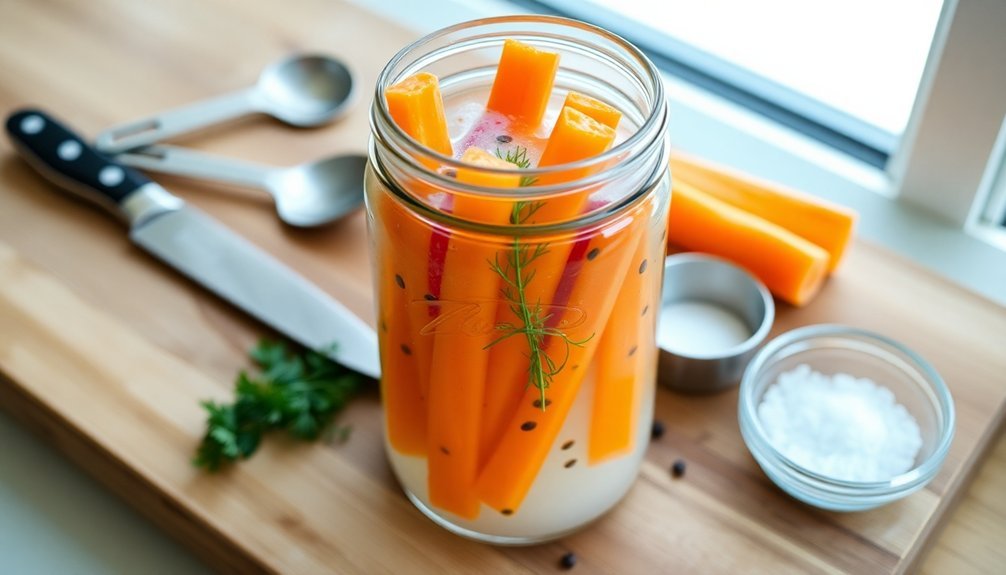
Getting started with quick pickled carrots calls for up to seven basic ingredients and five essential pieces of equipment.
You'll need distilled white vinegar (⅔ to 1 cup) and water (⅓ to 1 cup) as your liquid base. Add sea salt or pickling salt (½ teaspoon to 2 tablespoons) and organic cane sugar (1 to 2 tablespoons) to create the perfect brine balance. When selecting carrots, small varieties work best for quick pickling without requiring additional preparation.
For extra flavor, you can include optional additives like garlic, dill, black peppercorns, cumin seeds, coriander seeds, or red pepper flakes.
For equipment, you'll want to gather 16-ounce or 25oz glass Mason jars with matching lids and bands. You'll also need a saucepan to heat your brine mixture, along with basic utensils like a spoon, whisk, or spatula for stirring and pouring.
Don't forget to clear some space in your refrigerator, as you'll need room to store your jars during the marinating process. These containers should be clean and ready to use, ensuring proper storage of your pickled carrots for up to a month when refrigerated properly.
Preparing Fresh Carrots
Prior to pickling, you'll need to properly prepare your fresh carrots to guarantee the best possible results. Start by selecting firm, fresh carrots of similar size, making certain they're free from damage, rot, or signs of Carrot Root Fly infestation. Baby carrots or smaller varieties work particularly well as they pickle more quickly. This preparation method ensures the carrots maintain their high fiber content throughout the pickling process.
Once you've chosen your carrots, wash them thoroughly to remove any dirt or debris. If you're using non-organic carrots or ones with particularly dirty skin, peel them using a potato peeler. For cleaner carrots, you can simply scrape the surface with a knife. Don't forget to remove any ferny leaves and roots.
Next, cut your carrots into your preferred shape – sticks, rounds, or matchstick juliennes. Use a sharp knife to make certain clean cuts and maintain consistent widths for uniform pickling. If you're looking for a faster pickling process, you can grate the carrots instead.
Before proceeding with the pickling process, make sure your prepared carrots are completely dry to prevent excess moisture.
You'll want to use them right away for the best results, but if needed, store them in a cool, dry place until you're ready to pickle.
Making the Pickling Brine
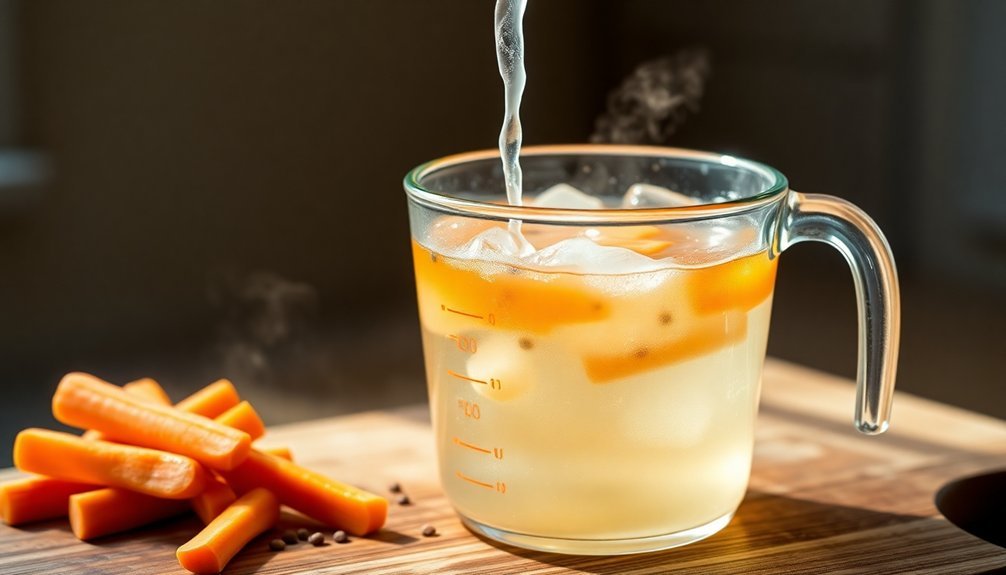
For a successful pickling brine, you'll need to start with the right ratio of vinegar, water, salt, and optional sugar. Combine these ingredients in a small saucepan and bring the mixture to a simmer over medium heat, stirring until the salt and sugar completely dissolve. The mixture takes about 10 minutes to heat properly.
Once dissolved, you can enhance the flavor by adding spices like coriander seeds, black peppercorns, and dill seed.
For extra depth, consider incorporating red pepper flakes for heat, fresh dill for brightness, or unique additions like cloves, star anise, or ginger. You'll want to adjust these seasonings based on your taste preferences, adding more or less as needed.
- Watch the brine simmer gently, releasing aromatic steam
- See the salt and sugar crystals disappear as they dissolve
- Notice the spices bobbing in the hot liquid
- Observe the brine turn slightly cloudy then clear
- Smell the vinegar and spices combining into a tangy aroma
Once you've achieved the desired flavor, remove the brine from heat and let it cool to room temperature.
If you're keen to start pickling, you can pour the hot brine directly over your prepared carrots, ensuring they're fully submerged. Let them marinate for at least an hour before enjoying.
Packing and Processing Steps
Proper packing and processing are essential steps that guarantee your pickled carrots stay fresh and flavorful.
Start by adding your chosen spices to the bottom of clean, hot wide-mouth pint jars. You'll want to fill the jars about three-quarters full with your uniformly cut carrot pieces, whether you've chosen rounds, sticks, or julienne cuts.
Pour the hot pickling liquid over your carrots until they're completely submerged. You'll need to remove any air bubbles by gently tapping the jar on your counter or using a nonmetallic utensil.
Don't forget to wipe the jar rims with a clean, damp paper towel before securing the two-piece metal canning lids according to the manufacturer's instructions.
Let your filled jars cool undisturbed for 12 to 24 hours, then check the seals. If you haven't used a boiling water canner, store your jars in the refrigerator.
For the best flavor development, you'll want to wait 3 to 5 days before enjoying your pickled carrots. Before consuming, always check that the pickling liquid remains clear and free of any mold.
Storage and Shelf Life
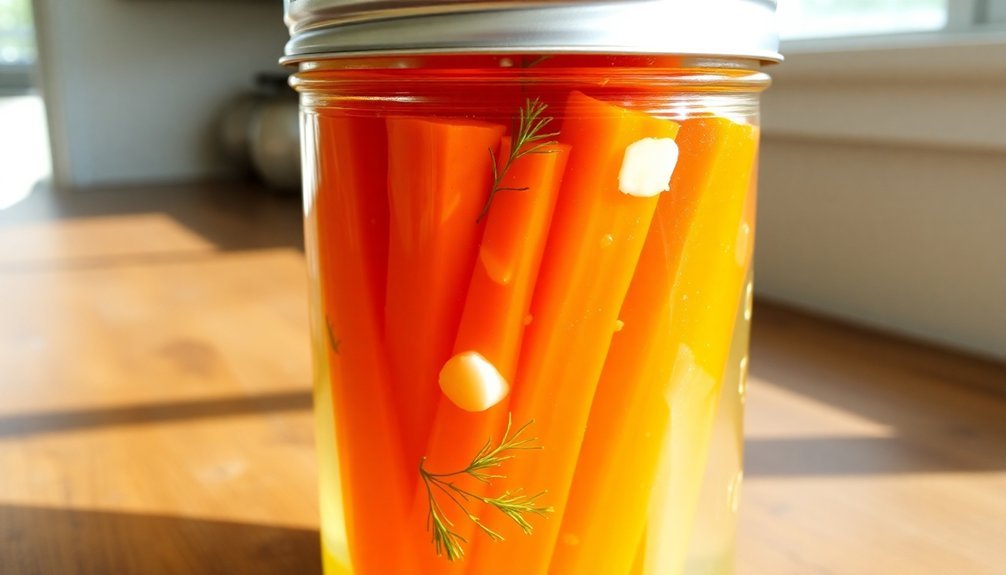
Successful storage of quick pickled carrots relies on airtight containers and consistent refrigeration.
You'll want to store your pickled carrots in glass jars with tight-fitting lids, though ceramic containers can work if you don't have glass available. Make sure your container is non-reactive to prevent any unwanted changes in flavor or texture.
Keep your pickled carrots in the refrigerator, where they'll last up to 2 weeks when stored properly. While some recipes suggest they can last up to 2 months, you'll get the best flavor and crunch if you consume them within 3-5 days.
Don't store them at room temperature or try to freeze them, as this can compromise both safety and quality.
Watch for these signs that indicate your pickled carrots are properly stored:
- The pickling liquid remains clear with no cloudiness
- Carrots stay fully submerged in the brine
- The container lid maintains a tight seal
- No unusual odors are present
- The vegetables maintain their crisp texture
Remember to check your pickled carrots regularly for any signs of spoilage, such as mold growth or off-putting smells. If you notice anything suspicious, it's best to discard them.
Flavor Variations and Additions
You can create unique flavor profiles for your pickled carrots by experimenting with Asian-inspired spices like star anise, ginger, and Szechuan peppercorns.
For a bright, citrus-forward variation, try adding orange or lemon peels along with fresh herbs like dill, tarragon, or cilantro.
If you're looking to balance sweet and savory notes, combine classic pickling spices with fresh herbs and a touch of citrus zest for a well-rounded flavor.
Asian-Inspired Pickling Spices
Creating bold Asian flavors in your pickled carrots comes down to carefully selecting and balancing traditional Eastern ingredients and spices. Start with a rice vinegar base, which offers a gentler acidity compared to white vinegar, and combine it with lite soy sauce and a touch of sesame oil for depth.
You'll want to balance these liquids with sugar or a natural sweetener like agave to create that characteristic sweet-sour profile.
For authentic Asian-inspired pickled carrots, you'll need these essential components:
- Fresh ginger paste or minced ginger root for a zingy, warming kick
- Toasted sesame seeds to add nutty complexity and visual appeal
- Thinly sliced red chilies or red pepper flakes for customizable heat
- Minced garlic and sliced shallots for savory depth
- Fresh mint leaves for brightness and contrast
Toast your spices before adding them to intensify their flavors, and remember to whisk all ingredients thoroughly before pouring over your prepared carrots.
Let the mixture marinate for at least an hour, though overnight soaking will deliver the most pronounced flavors. For extra crunch and visual appeal, garnish with additional sesame seeds just before serving.
Herb and Citrus Blends
While Asian-inspired pickling offers bold and complex flavors, herb and citrus combinations bring a fresh, Mediterranean-style approach to quick pickled carrots. You can create vibrant flavors by combining fresh herbs like basil, dill, and thyme with citrus elements such as lemon peel or orange zest.
For convenience, try using pre-made blends like herbes de Provence or Italian seasoning to achieve complex herb profiles with minimal effort.
To build a balanced herb and citrus blend, start with 2-3 complementary fresh herbs. Pair dill with parsley for a classic combination, or mix basil with thyme for a more Mediterranean touch.
Add citrus elements by incorporating strips of lemon or orange peel, or boost the brightness with a splash of fresh citrus juice in your pickling liquid.
You'll want to enhance these primary flavors with supporting spices like black peppercorns, coriander seeds, or mustard seeds. For additional depth, consider adding sliced garlic or a touch of honey to balance the acidity.
If you're short on time, quality store-bought pickling spice blends can provide a reliable foundation for your herb and citrus variations.
Serving Ideas and Uses
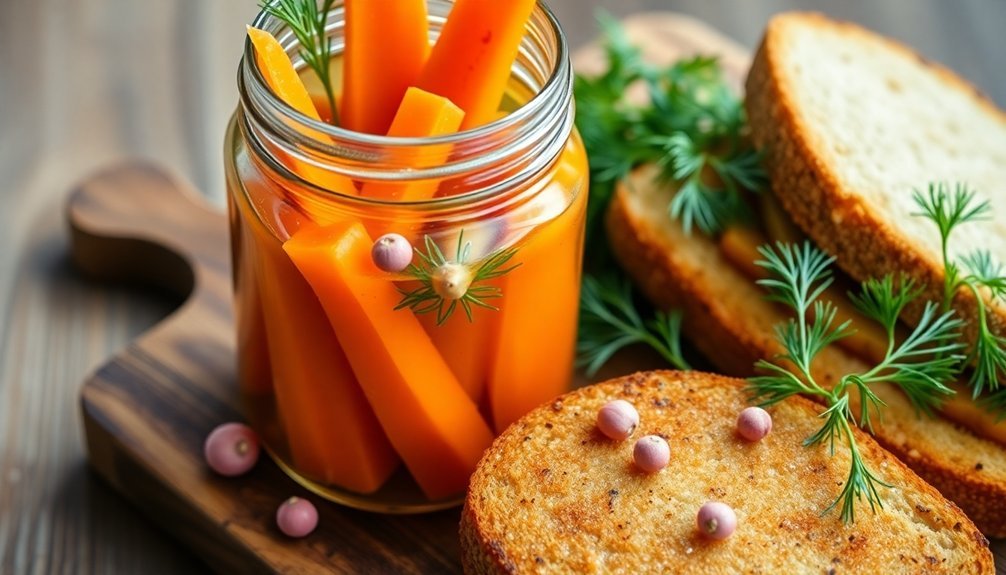
You'll find quick pickled carrots are incredibly versatile when added to Asian dishes like banh mi sandwiches, noodle bowls, and sushi rolls.
These tangy pickles can transform your everyday salads by adding a bright crunch when tossed with fresh greens, quinoa, or grain bowls.
They're also a standout addition to party platters, where they can complement other appetizers and add a pop of color and zesty flavor to your spread.
Pairing With Asian Dishes
From Korean BBQ to Vietnamese banh mi, quick pickled carrots bring a vibrant crunch and tangy punch to countless Asian dishes.
You'll find these versatile pickled carrots adding zest to Korean-style beef tacos, enhancing the flavors of sushi rolls, and bringing life to quinoa bowls. They're particularly excellent when paired with grilled meats, especially in Korean BBQ settings, where their acidity cuts through rich flavors.
These pickled carrots work wonderfully in various Asian-inspired preparations, whether you're making traditional dishes or fusion cuisine.
You can incorporate them into kimchi for extra crunch, use them as a bright addition to Japanese bento boxes, or add them to Thai-style salads for an extra layer of tang.
- Top your Korean-style fried chicken with pickled carrots and sriracha mayo
- Layer them in banh mi sandwiches with cilantro and crushed peanuts
- Mix into rice paper rolls with fresh herbs and vermicelli noodles
- Add to Asian-inspired grain bowls with sesame seeds and pan-fried tofu
- Incorporate into dim sum plates or use as a side for grilled meats
Fresh Salad Mix-Ins
Quick pickled carrots regularly transform everyday salads into vibrant, flavor-packed meals. You'll find they're particularly versatile when combined with other fresh and crunchy ingredients to create balanced, satisfying salads.
Try pairing your pickled carrots with protein-rich elements like hard-boiled eggs, grilled chicken, or baked tofu to make your salad more filling and nutritious.
For a Mediterranean-inspired combination, mix your pickled carrots with feta cheese, chickpeas, and chopped almonds. If you're looking for a Mexican-style salad, combine them with black beans, crushed tortilla chips, and pickled jalapeños.
The tangy carrots work exceptionally well with other pickled ingredients like red onions and banana peppers, creating layers of acidic flavors.
Don't forget to add sweet elements to balance the tartness of your pickled carrots. Dried cranberries, raisins, or diced apples provide a pleasant contrast.
For additional texture, incorporate sunflower seeds or croutons. You can also pair the carrots with earthy ingredients like beets or creamy elements such as cubed cheese to create a well-rounded salad experience.
Party Platter Additions
Beyond their role in salads, pickled carrots shine as versatile additions to party platters and appetizer spreads. You'll find these tangy vegetables enhance both casual gatherings and formal events, offering a perfect balance of crunch and acidity.
Whether you're assembling a charcuterie board or creating themed holiday displays, pickled carrots can elevate your presentation while adding complex flavors to the mix.
For maximum impact, incorporate your pickled carrots into various platter styles. Add them to cheese boards alongside aged cheddars and soft bries, or pair them with Mediterranean spreads like hummus and tzatziki.
They're particularly effective in antipasto arrangements, complementing cured meats and marinated olives. You can also use them to add height and color to vegetable platters or include them in creative seasonal displays.
- Create a Greek-inspired spread with feta, olives, and pickled carrots
- Add to charcuterie boards between meat and cheese selections
- Arrange alongside various crackers and crusty bread options
- Include in Halloween-themed veggie platters for festive color
- Mix with other pickled vegetables for a tangy snack assortment
Frequently Asked Questions
Can I Reuse the Leftover Pickling Brine for a New Batch?
You can reuse pickling brine once or twice, but only for quick refrigerator pickles. Don't use it for canning. Keep your reused-brine pickles refrigerated and consume them within 3-4 weeks for safety.
Why Did My Pickled Carrots Turn Slightly Blue or Gray?
Your pickled vegetables might turn blue-gray when acids from vinegar react with minerals in your produce or cookware. It's completely safe to eat, but you can prevent it by using non-reactive containers next time.
Is It Necessary to Sterilize Jars for Quick-Pickled Carrots?
You don't need to sterilize jars for quick pickles since they're stored in the refrigerator. Just wash and rinse your jars thoroughly with hot, soapy water before filling them to guarantee cleanliness.
Can I Use Baby Carrots Instead of Regular Carrots?
Yes, you can absolutely use baby carrots! They're pre-trimmed and perfectly sized for pickling. They'll absorb flavors quickly due to their smaller size, and you won't need to do much cutting or peeling.
Will Pickled Carrots Maintain Their Crunch After Several Weeks?
Your pickled carrots will gradually soften over time, but they'll maintain some crunch for 2-3 weeks if properly refrigerated. After that, you'll notice they become progressively softer and less appealing to eat.
In Summary
Now that you've mastered quick pickled carrots, you'll have a versatile condiment ready for countless dishes. They'll last up to 2 months in your fridge, adding crunch and tangy flavor whenever you need them. Don't hesitate to experiment with different spices and seasonings to create your own signature pickle blend. These carrots are perfect for sandwiches, salads, charcuterie boards, or straight from the jar.

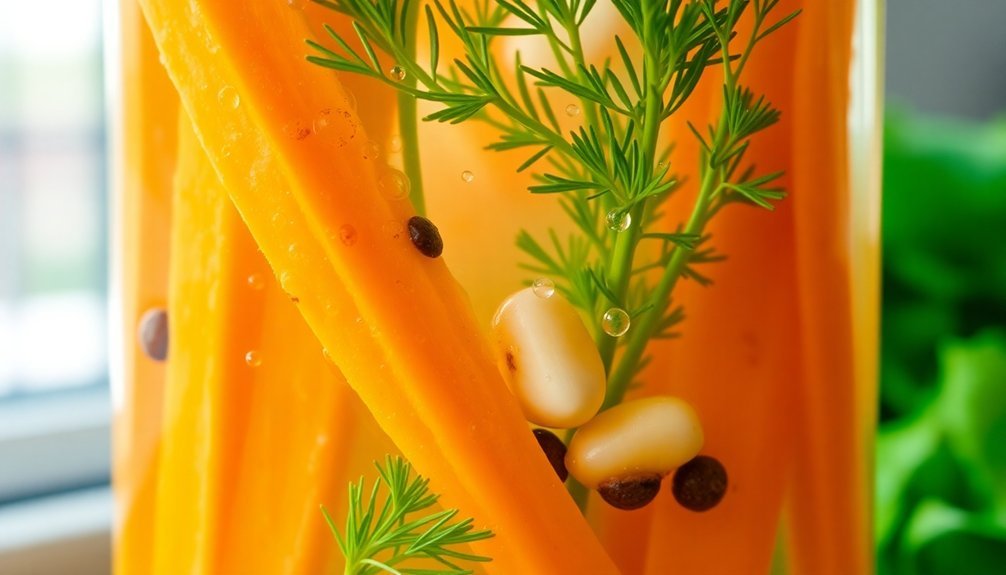



Leave a Reply